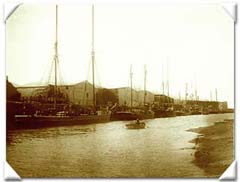
Developing trade and port histories: Outports - Port Wakefield
- Introduction
- Ardrossan
- Ceduna/Thevenard
- Connecting Kangaroo Island
- Fleurieu Peninsula Ports
- Fleurieu Peninsula Ports continued
- Klein Point
- Port Augusta
- Port Elliot
- Port Germein
- Port Giles
- Port Lincoln
- Port MacDonnell
- Port Pirie
- Port Victoria
- Port Wakefield
- Robe
- Victor Harbor
- Victor Harbor continued
- Wallaroo
- Whyalla and Port Bonython
Port Wakefield
 The regions immediately to the north and south of Adelaide were the earliest areas to be explored following settlement in 1836. The discovery of the Wakefield River in 1838 by William Hill was followed by further discoveries by explorers such as Edward Eyre and Robert Cock. Pastoralists followed them, taking up land with reasonable supplies of water. Soon they would need an outlet for the wool they produced. But the genesis of Port Wakefield was not the wool trade, but the copper boom at Kapunda and Burra in 1842 and 1845. Carriage of the copper ore was by bullock wagon, some 145 kilometres by rough track that became impassable in winter. Another solution was needed. The mouth of the Wakefield River was found to be suitable - it was considered 'easy of approach and secure' despite a sandbar blocking the estuary and access only for vessels of shallow draught. Thomas Lipson, the colony's harbourmaster, investigated the site, and recommended that a channel be dredged through the sandbar. This was done, shipments of ore and supplies being made at the same time. By March 1850 dredging was almost complete, and the sale of town land began shortly after. Port Wakefield had the unusual distinction of being a government town, but founded because of the need and initiative of the privately owned copper mines.
The regions immediately to the north and south of Adelaide were the earliest areas to be explored following settlement in 1836. The discovery of the Wakefield River in 1838 by William Hill was followed by further discoveries by explorers such as Edward Eyre and Robert Cock. Pastoralists followed them, taking up land with reasonable supplies of water. Soon they would need an outlet for the wool they produced. But the genesis of Port Wakefield was not the wool trade, but the copper boom at Kapunda and Burra in 1842 and 1845. Carriage of the copper ore was by bullock wagon, some 145 kilometres by rough track that became impassable in winter. Another solution was needed. The mouth of the Wakefield River was found to be suitable - it was considered 'easy of approach and secure' despite a sandbar blocking the estuary and access only for vessels of shallow draught. Thomas Lipson, the colony's harbourmaster, investigated the site, and recommended that a channel be dredged through the sandbar. This was done, shipments of ore and supplies being made at the same time. By March 1850 dredging was almost complete, and the sale of town land began shortly after. Port Wakefield had the unusual distinction of being a government town, but founded because of the need and initiative of the privately owned copper mines.
It is considered the first of South Australia's outports to be founded. As a port it was officially proclaimed 12 September 1850: basic facilities were rapidly established. Prior to its proclamation the port had already trans-shipped 6000 tons of coal, and 1156 tons of copper - the distance to the mines had been halved, with a corresponding reduction in costs. The copper company maintained its own fleet of barges.
The area between Port Wakefield and Burra prospered as a result of the 'copper spinoff'. However, as in other instances such as at Port MacDonnell, and later some of the River Murray ports, the advent of the railway changed this. The mining companies switched to rail for the transport of their copper, and for their incoming supplies. Generous government concessions fostered the change.
However Port Wakefield found a new product to ship - wool and later wheat. In 1866 the port was beaten only by Port Adelaide in its wool exports, exporting over 3,300,000 pounds of wool. For the pastoralists east of the head of the gulf, Port Wakefield was the obvious port. It was considered by a number of captains to be a safe harbour, and the turn around time to be quick and efficient. Customs facilities were established at the port in 1855 because of the number of ships sailing direct to and from overseas ports.
In 1870 a tramway was opened to tap the potential of the inland, and was successful in bringing produce into Port Wakefield for trans-shipment. The line was extended five years later. Three years later another stretch of railway was laid which gave farmers and pastoralists direct access to the deepwater port at Wallaroo. Port Wakefield, the town, rather than the port, adapted. The railway workshops established in the town were a boon.
Wheat was now to become the major export from Port Wakefield - agricultural expansion was rapid following the development of mullenizing to clear the scrub, new grubbers for digging the stumps, and finally in 1876 the invention of the stump jump plough. The wharfs of Port Wakefield became stacked high with sacks of wheat waiting for shipment in the ketches of the mosquito fleet, or by lighters to the large ships anchored in deep water. In 1909, 300,000 bags of wheat were exported; 1840 bales of wool were also shipped.
Fishing also was carried out from the port; beginning from the 1860s modern refrigeration has ensured that this remains a useful addition to the port's viability. But again the railways dealt a blow - the broad gauge railway link to the east/west railway bypassed Port Wakefield, and the railway workshops were relocated to Peterborough. Port Wakefield became a fishing port - the heyday of the ketch trade is long gone. Yet the town continues to prosper, servicing the heavy road traffic that travels to Yorke Peninsula and the north.
Further reading:
Donovan, P. F. Port Wakefield and district, a history: commemorating a century of local government [Port Wakefield, S. Aust.]: Port Wakefield District Council, 1978
Items 1 - 12 of 33














